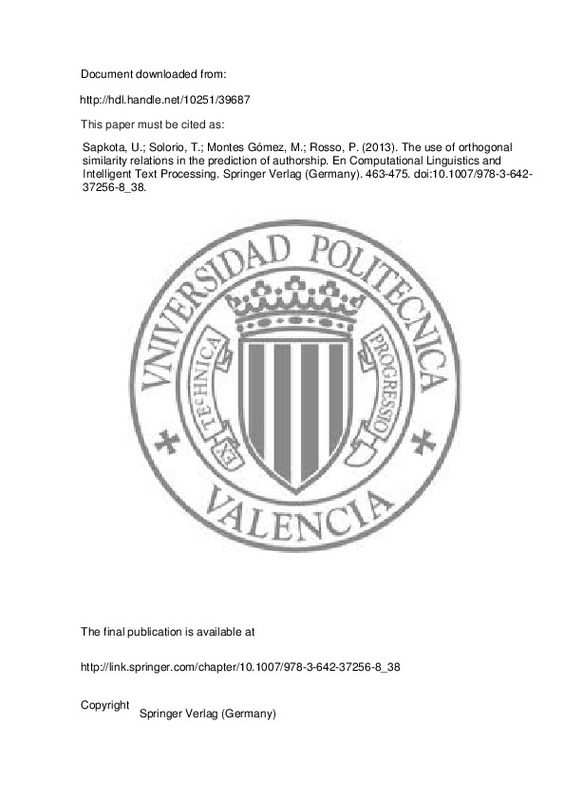Baker, L.D., McCallum, A.: Distributional clustering of words for text classification. In: SIGIR 1998: Proceedings of the 21st Annual International ACM SIGIR, pp. 96–103. ACM, Melbourne (1998)
Biber, D.: The multi-dimensional approach to linguistic analyses of genre variation: An overview of methodology and findings. Computers and the Humanities 26, 331–345 (1993)
Blum, A., Mitchell, T.: Combining labeled and unlabeled data with co-training. In: Proceedings of the 1998 Conference on Computational Learning Theory (1998)
[+]
Baker, L.D., McCallum, A.: Distributional clustering of words for text classification. In: SIGIR 1998: Proceedings of the 21st Annual International ACM SIGIR, pp. 96–103. ACM, Melbourne (1998)
Biber, D.: The multi-dimensional approach to linguistic analyses of genre variation: An overview of methodology and findings. Computers and the Humanities 26, 331–345 (1993)
Blum, A., Mitchell, T.: Combining labeled and unlabeled data with co-training. In: Proceedings of the 1998 Conference on Computational Learning Theory (1998)
Dhillon, I.S., Mallela, S., Kumar, R.: A divisive information-theoretic feature clsutering algorithm for text classification. Journal of Machine Learning Research 3, 1265–1287 (2003)
Escalante, H.J., Montes-y-Gómez, M., Solorio, T.: A weighted profile intersection measure for profile-based authorship attribution. In: Batyrshin, I., Sidorov, G. (eds.) MICAI 2011, Part I. LNCS, vol. 7094, pp. 232–243. Springer, Heidelberg (2011)
Escalante, H.J., Solorio, T., Montes-y-Gomez, M.: Local histograms of character n-grams for authorship attribution. In: Proceedings of the 49th Annual Meeting of the Association for Computational Linguistics: Human Language Technologies, pp. 288–298. Association for Computational Linguistics, Portland (2011)
Hayes, J.H.: Authorship attribution: A principal component and linear discriminant analysis of the consistent programmer hypothesis. I. J. Comput. Appl., 79–99 (2008)
Houvardas, J., Stamatatos, E.: N-gram feature selection for authorship identification. In: Euzenat, J., Domingue, J. (eds.) AIMSA 2006. LNCS (LNAI), vol. 4183, pp. 77–86. Springer, Heidelberg (2006)
Karypis, G.: CLUTO - a clustering toolkit. Tech. Rep. #02-017 (November 2003)
Keselj, V., Peng, F., Cercone, N., Thomas, C.: N-gram based author profiles for authorship attribution. In: Proceedings of the Pacific Association for Computational Linguistics, pp. 255–264 (2003)
Koppel, M., Schler, J., Argamon, S.: Authorship attribution in the wild. Language Resources and Evaluation 45, 83–94 (2011)
Lewis, D.D., Yang, Y., Rose, T.G., Li, F.: Rcv1: A new benchmark collection for text categorization research. Journal of Machine Learning Research 5, 361–397 (2004)
Luyckx, K., Daelemans, W.: Authorship attribution and verification with many authors and limited data. In: Proceedings of the 22nd International Conference on Computational Linguistics (Coling 2008), Manchester, UK, pp. 513–520 (August 2008)
Luyckx, K., Daelemans, W.: The effect of author set size and data size in authorship attribution. In: Literary and Linguistic Computing, pp. 1–21 (August 2010)
Marneffe, M.D., MacCartney, B., Manning, C.D.: Generating typed dependency parses from phrase structure parses. In: LREC 2006 (2006)
Plakias, S., Stamatatos, E.: Tensor space models for authorship identification. In: Darzentas, J., Vouros, G.A., Vosinakis, S., Arnellos, A. (eds.) SETN 2008. LNCS (LNAI), vol. 5138, pp. 239–249. Springer, Heidelberg (2008)
Raghavan, S., Kovashka, A., Mooney, R.: Authorship attribution using probabilistic context-free grammars. In: Proceedings of the ACL 2010 Conference Short Papers, pp. 38–42. Association for Computational Linguistics, Uppsala (2010)
Slonim, N., Tishby, N.: The power of word clusters for text classification. In: 23rd European Colloquium on Information Retrieval Research, ECIR (2001)
Solorio, T., Pillay, S., Raghavan, S., Montes-y-Gómez: Generating metafeatures for authorship attribution on web forum posts. In: Proceedings of the 5th International Joint Conference on Natural Language Processing, IJCNLP 2011, pp. 156–164. AFNLP, Chiang Mai (2011)
Stamatatos, E.: Author identification using imbalanced and limited training texts. In: 18th International Workshop on Database and Expert Systems Applications, DEXA 2007, pp. 237–241 (September 2007)
Stamatatos, E.: Author identification: Using text sampling to handle the class imbalance problem. Information Processing and Managemement 44, 790–799 (2008)
Stamatatos, E.: Plagiarism detection using stopword n-grams. Journal of the American Society for Information Science and Technology 62(12), 2512–2527 (2011)
Stamatatos, E.: A survey on modern authorship attribution methods. Journal of the American Society for Information Science and Technology 60(3), 538–556 (2009)
Stolcke, A.: SRILM - an extensible language modeling toolkit, pp. 901–904 (2002)
Toutanova, K., Klein, D., Manning, C.D., Singer, Y.: Feature-rich part-of-speech tagging with a cyclic dependency network. In: Proceedings of the 2003 Conference of the North American Chapter of the Association for Computational Linguistics on Human Language Technology, NAACL 2003, vol. 1, pp. 173–180 (2003)
de Vel, O., Anderson, A., Corney, M., Mohay, G.: Multi-topic e-mail authorship attribution forensics. In: Proceedings of the Workshop on Data Mining for Security Applications, 8th ACM Conference on Computer Security (2001)
Witten, I.H., Frank, E.: Data Mining: Practical Machine Learning Tools and Techniques, 2nd edn. Morgan Kaufmann (2005)
[-]









